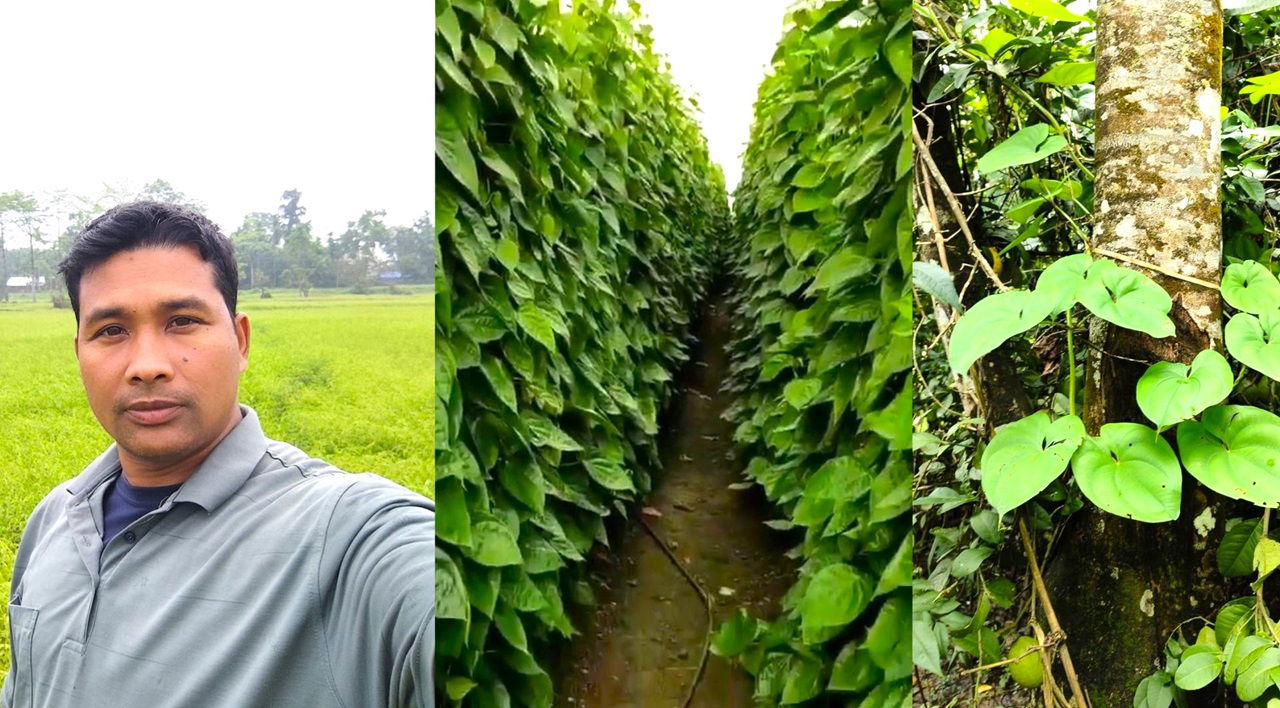
At the core of India’s agricultural region, where traditional practices often resist change, a pioneering farmer is reshaping betel leaf cultivation. Dhoniram Chetia, from Pengaree in Digboi, Assam—a region where conventional methods have long been the norm, has embraced a modern technique that is set to redefine betel leaf farming. Shifting from the traditional spacing of betel vines 5-6 feet apart, Chetia’s innovative method makes more efficient use of space and dramatically boosts productivity.
A Modern Approach to Cultivation
During a recent visit by Krishi Jagran team to Chetia's farm, it became evident that his approach is nothing short of revolutionary. Unlike the traditional method, which sprawls betel vines across a larger area, Chetia plants his betel vines just 2 feet apart in both rows and between rows. This compact arrangement allows for four betel vines to thrive in just 2 square feet of space. The key to success in this method lies in ensuring that all vines are of equal age. This uniformity prevents competition among the vines, leading to even growth and maximizing yield.
Chetia’s method is visually striking and highly effective. By maintaining uniform growth and equal spacing, the vines are less likely to overshadow one another, which is a common issue with traditional methods. This careful arrangement ensures that each vine receives adequate sunlight and nutrients, resulting in healthier plants and a more abundant harvest.
Advantages of the New Technique
-
Increased Yield in Less Space: One of the most significant advantages of Chetia's method is its ability to boost yield without requiring additional land. Traditional betel leaf cultivation demands more space, but by adopting Chetia’s technique, farmers can plant a higher density of vines in the same area. This not only maximizes the use of available land but also increases overall production. As Chetia himself notes, “By using less space, we are able to produce more. This technique is a game-changer for us.”
-
Easier Harvesting: Harvesting betel leaves traditionally can be labor-intensive, requiring the separation of individual vines. Chetia’s method simplifies this process by allowing multiple vines to be harvested simultaneously. This efficiency reduces labor costs and streamlines the harvesting process, making it more manageable and less time-consuming. “Harvesting has become so much easier. We can gather leaves from several vines at once, saving both time and effort,” Chetia shares.
-
Efficient Fertilization and Watering: Fertilizing and watering are critical components of betel leaf cultivation. Chetia’s compact planting arrangement allows for quicker and more efficient application of these resources. He ensures that the nutrients and water are evenly distributed, promoting healthy growth and reducing waste by addressing four vines at once. “With this method, we can apply fertilizers and water more effectively. It’s a more efficient use of resources,” Chetia explains.
-
Integrated Farming Opportunities: The spacing between the betel vines, while compact, offers opportunities for integrated farming. Farmers can utilize the spaces between the vines for growing other crops or for mixed farming practices. This integration not only enhances productivity but also contributes to a more diverse and sustainable farming ecosystem. As Chetia puts it, “We can use the space between the vines for other crops, making the most of every inch of land we have.”
From Test to Triumph
Chetia's journey with this new method began with small-scale tests. Initially cautious, he carefully monitored the results of his approach to ensure its viability. The success of these initial trials spurred him to expand the technique to a larger area. The positive outcomes validated his approach and showcased its potential for widespread application.
The story of Dhoniram Chetia is not just about personal achievement; it represents a significant shift in betel leaf farming practices. His innovative technique has the potential to inspire other farmers to rethink traditional methods and embrace modern practices that promise greater efficiency and productivity. “I am excited to see how this method can help other farmers. If it worked for me, it can work for many others,” Chetia remarks.
Dhoniram Chetia's success story highlights the impact of innovation in agriculture. His modern approach to betel leaf cultivation not only enhances yield and efficiency but also paves the way for integrated farming practices. As more farmers take note of his achievements, Chetia's method may very well become a new standard in the industry, proving that progress and tradition can harmoniously coexist for the betterment of agriculture.
















